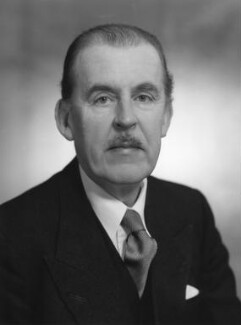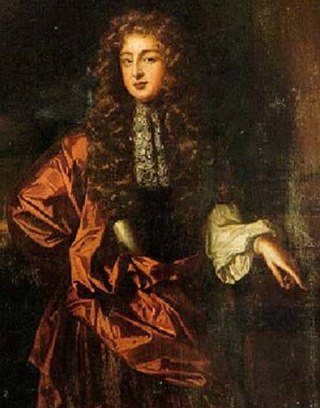Related Research Articles
James Hamilton, 1st Earl of AbercornPC (S) (1575–1618) was a Scottish diplomat for James VI and an undertaker in the Plantation of Ulster, Ireland.

The title Duke of Abercorn is a title in the Peerage of Ireland. It was created in 1868 and bestowed upon James Hamilton, 2nd Marquess of Abercorn. Although the Dukedom is in the Peerage of Ireland, it refers to Abercorn, West Lothian, and the Duke also bears four titles in the Peerage of Scotland and two in the Peerage of Great Britain, and is one of only three peers who have titles in those three peerages. The Duke of Abercorn also claims the French title of Duke of Châtellerault, created in 1548.

Earl of Castlehaven was a title in the Peerage of Ireland, created on 6 September 1616. It was held in conjunction with the Barony of Audley, the Barony of Audley of Orier, and the Barony of Audley of Hely.

James Hamilton, 5th Duke of Abercorn,, styled Viscount Strabane until 1953 and Marquess of Hamilton between 1953 and 1979, is a British peer, courtier and politician.

James Edward Hamilton, 4th Duke of Abercorn styled Viscount Strabane until 1913 and Marquess of Hamilton between 1913 and 1953, was a British peer. He was the son of James Hamilton, 3rd Duke of Abercorn, and Lady Rosalind Cecilia Caroline Bingham. He inherited his father's peerages on 12 September 1953.

Earl of Seaforth was a title in the Peerage of Scotland and the Peerage of Ireland, derived from Loch Seaforth on the coast of Lewis. It was held by the family of Mackenzie from 1623 to 1716, and again from 1771 to 1781.

Claud Hamilton, 1st Lord Paisley was a Scottish nobleman who fought at the Battle of Langside in 1568 for Mary, Queen of Scots. He is the ancestor of the earls, marquesses and dukes of Abercorn.
James Hamilton, 2nd Earl of Abercorn was a Catholic Scottish nobleman. He, his wife, his mother, and most of his family were persecuted by the kirk as recusants. Implementing his father's will, he gave his Irish title of Baron Hamilton of Strabane to his younger brother Claud. His younger brothers inherited his father's Irish lands, while he received the Scottish ones, which he squandered away, being deep in debt in his later days.
Claud Hamilton may refer to:
George Hamilton, 3rd Earl of Abercorn died unmarried in Padua on a voyage to Rome. He was succeeded by Claud Hamilton, heir of Claud Hamilton, 2nd Baron Hamilton of Strabane, second son of the 1st Earl of Abercorn.
Claud Hamilton, 2nd Baron Hamilton of Strabane was the founder of the Strabane branch of the Hamiltons. He died relatively young at about 32 and his wife, Jean Gordon, married Sir Phelim O'Neill, one of the leaders of the 1641 rebellion, after his death.
George Hamilton, 4th Baron Hamilton of Strabane was the younger son of Claud Hamilton, 2nd Baron Hamilton of Strabane. He succeeded to the title in 1655 when his brother drowned while bathing in the River Mourne. After the Restoration, he obtained the return of the family lands around Strabane, which had been confiscated by the Parliamentarians in 1650.

Claud Hamilton, 4th Earl of Abercorn PC (Ire) (1659–1691) was a Scottish and Irish peer who fought for the Jacobites in the Williamite War. He went with King James to Derry in 1689 and tried to negotiate the surrender of the town with Adam Murray. He raised a regiment of horse that he led in the defeats of Newtownbutler in 1689 and Aughrim in 1691. He was killed when the ship that should have brought him to France was intercepted by a Dutch privateer.
Charles Hamilton, 5th Earl of Abercorn succeeded his brother who had been attainted as a Jacobite and, having conformed to the established religion, could get the attainder reversed.

James Hamilton, 6th Earl of Abercorn, PC (Ire), was a Scottish and Irish peer and politician. Appointed a groom of the bedchamber to Charles II after his father's death in battle, he took the Williamite side at the Glorious Revolution and in March 1689 supplied Derry with stores that enabled the town to sustain the Siege of Derry until it was relieved in August. Shortly after inheriting a Scottish and Irish peerage from a second cousin, he was created a viscount in Ireland for his services to the Williamite cause.

James Hamilton, 7th Earl of AbercornPC (Ire) (1686–1744), styled Lord Paisley from 1701 to 1734, was a Scottish and Irish nobleman and peer. An amateur scientist and musician, he published a book on magnetism in 1729 and a treatise on musical harmony in 1730, which was subsequently emended and re-issued by his teacher, Dr. Pepusch.
James Hamilton, Lord Paisley was the eldest son of James Hamilton, 2nd Earl of Abercorn and Katherine Clifton, 2nd Baroness Clifton. Born a Catholic he became a Presbyterian before 1646. He predeceased his father and is therefore an example of an heir apparent who never succeeded.
Sir George Hamilton, 1st Baronet of Donalong and Nenagh, was born in Scotland, but inherited land in Ireland. Despite being Catholic, he served his Protestant brother-in-law, the 1st Duke of Ormond, lord lieutenant of Ireland, in diplomatic missions during the Confederate Wars and as receiver-general of the royalists. He also defended Nenagh Castle against the Parliamentarians during the Cromwellian conquest of Ireland. Hamilton was father of Anthony, author of the Mémoires du Comte de Grammont, of Richard, Jacobite general, and of Elizabeth, "la belle Hamilton".
William Douglas, 1st Marquess of Douglas and 11th Earl of Angus (1589–1660) was a Scottish nobleman.
Sir George Hamilton of Greenlaw and Roscrea was an undertaker in the Plantation of Ulster. Born and bred in Scotland, by 1611 he had moved to Ireland with his Scottish wife to occupy his plantation grant. In 1630 he married his second wife and moved to Roscrea in southern Ireland, which his father-in-law, Walter Butler, 11th Earl of Ormond, leased to him in lieu of dowry.
References
- Cokayne, Complete Peerage, sub Abercorn, and Hamilton of Strabane.